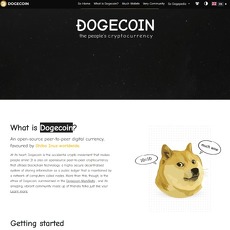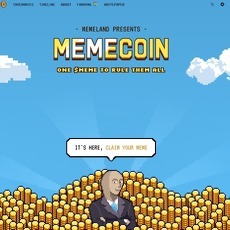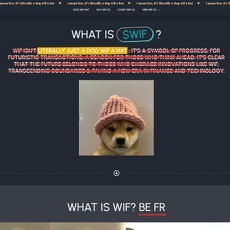Best Top Memes Tokens and coins that could be legit
Meme Coins: Everything You Need to Know (With FAQ)
Do you ever look at Dogecoin or Shiba Inu and wonder what these “meme coins” are all about? Are they just funny internet jokes turned into cryptocurrency, or is there more to the story? Whether you see them as quirky investments or unnecessary distractions, it’s clear meme coins have shaken up the crypto world in their own unique way.
Here’s the truth—there’s more going on behind the scenes than just memes and laughable ticker symbols. Some people are making serious money, while others are losing it just as quickly. And don’t forget, social media plays a huge role here, elevating some coins overnight and leaving others in the dust.
Why do meme coins make people curious but cautious?
Meme coins are fun, unpredictable, and absolutely wild at times. That makes them exciting—but also makes people hesitant. After all, not every meme coin is another Dogecoin (some are total disasters). Let’s break it down.
What makes people want to invest?
The appeal of meme coins lies in their ability to create hope, buzz, and, occasionally, fortune. Here’s why people get drawn in:
- Quick hype: Many meme coins generate massive buzz quickly—think viral TikToks, Elon Musk tweets, or Reddit threads blowing up overnight.
- Strong communities: Coins like Shiba Inu thrive because of passionate, almost cult-like communities that are supportive out of humor or shared purpose.
- Low entry cost: Some meme coins can be purchased for fractions of a cent, making them more accessible to people who want to test the waters without spending a fortune.
However, just because they’re “fun and cheap” doesn’t mean they’re risk-free. In fact, that low-cost accessibility is often why people treat them like lottery tickets—for better or worse.
Common risks involved
Of course, meme coins don’t come without their issues. Here are some major risks you need to understand:
- Volatility: Prices can shoot to the moon and crash just as fast. Stability isn’t the game here—it’s unpredictability.
- Lack of real utility: Unlike traditional cryptocurrencies like Ethereum, many meme coins don’t solve problems or offer significant technological use cases.
- Scams: Meme coins are often fertile ground for rug pulls and other bad actors looking to cash in on the hype. These scams can lead to people losing thousands—or even millions—overnight.
So while some investors get lucky, others find themselves holding worthless tokens after the hype dies down.
Are there any upsides?
Absolutely. If meme coins were all bad, they wouldn’t have such massive followings. Here’s what sets some apart:
- Survival of the fittest: A few meme coins, like Dogecoin, have staying power. With continued adoption and real-world use cases gradually being explored, these coins prove they’re more than a passing trend.
- Community strength: A strong community can push a meme coin forward, helping it gain visibility—and sometimes even legitimacy.
It’s not often that something originally created as a joke can turn into a multi-billion-dollar project, but in the world of cryptocurrency, anything seems possible.
Feeling excited yet cautious? Maybe you’re wondering why memes have such a big influence in the first place. Trust me, it’s a fascinating rabbit hole—keep reading, because that's exactly what we’ll explore next!
What Are Meme Coins?
Let’s face it—memes are everywhere. From your social media feed to the latest viral video, memes shape internet culture. But what if I told you some of these internet jokes are now worth millions? That’s the magic (and madness) of meme coins! They may start as silly ideas, but they’ve become a huge deal in the cryptocurrency space. So, what are they, really? Let’s break it down.
Defining Meme Coins
Meme coins are cryptocurrencies that are born from humor, internet culture, or viral trends. Think of Bitcoin as your serious, suit-wearing uncle who talks about finances. Meme coins? They’re your fun, carefree cousin who shows up to family gatherings with jokes and antics. The difference? While traditional cryptocurrencies like Bitcoin are designed with utility, scarcity, and broader use cases, meme coins are usually created for fun. Sometimes, they don’t have much technical substance behind them.
Take Dogecoin, for instance. Initially launched in 2013 as a parody of Bitcoin, it featured the popular Shiba Inu meme and wasn’t taken seriously… at first. Yet, over the years, Dogecoin's popularity exploded. Why? Because people related to it—memes are relatable. Add a strong community and word-of-mouth on social media, and this “joke” became a top cryptocurrency by market cap.
But Dogecoin is just the start. Other coins like Shiba Inu (self-titled the “Dogecoin Killer”) and PepeCoin have entered the spotlight. It’s worth noting, though, not every meme coin enjoys this level of attention. For every Dogecoin, there are hundreds of meme coins that came and went without anyone noticing.
Why Are Memes at the Heart of It?
Why memes? Because memes are fun—and fun gets attention. They tap into pop culture, shared humor, and the human need to feel included in something bigger. Whether it’s a Shiba Inu dog or the famous “Pepe the Frog,” memes are designed to make you feel something. Emotion drives engagement, and in this case, engagement fuels coin popularity.
Meme coins rely on virality. Without a meme or pop culture trend inspiring them, they wouldn’t exist. Here’s a quick look at some meme coins you've probably heard of:
- Dogecoin: The OG meme coin inspired by the “Doge” meme.
- Shiba Inu: Dogecoin’s rival and a fan favorite for crypto traders looking for “the next Dogecoin.”
- PepeCoin: A coin inspired by Pepe the Frog—another internet legend.
It’s memes, humor, and nostalgia that drive this world. When something goes viral (say, a funny tweet from Elon Musk), it often has a ripple effect, giving meme coins massive price boosts overnight. However, as exciting as this all sounds, not every meme coin has staying power. The internet is a fast-moving place, after all.
How Do Meme Coins Work?
Ever wonder how these funny coins are even created in the first place? The process is surprisingly simple. Meme coins operate on the same blockchain technology that powers other cryptocurrencies. For example, many meme coins are built on Ethereum as ERC-20 tokens, while others, like Dogecoin, have their own networks.
Here’s what typically happens behind the scenes:
- Creation: Developers create the coin—often with little technical complexity. Sometimes they fork existing code (like Bitcoin’s or Ethereum’s).
- Launch: Meme coins are then launched, often with a quirky backstory or viral campaign. Social media plays a huge role in their initial success.
- Trading: Once people notice the coin, it starts getting traded on exchanges. The more attention it gathers, the higher the demand—and price—can go.
But here’s the kicker: most meme coins don’t serve any real purpose beyond being traded for fun or speculation. They lack the “utility” that other crypto assets offer. Many people buy them simply to ride the hype wave, which is often short-lived.
“Internet humor can build fortunes overnight. But remember this: just because it’s funny doesn’t mean it’s safe.”
So, now that we know how meme coins started and what makes them tick, it raises an interesting question: why do some people adore them while others steer clear? Are meme coins really as innocent and fun as they seem, or is there a darker side? Stick around—you’ll want to see both sides of the story in the next section!
Why Do People Love (and Hate) Meme Coins?
Meme coins bring out the best and the worst in people. They’re fun and sometimes ridiculously profitable, but they’re also risky enough to cause sleepless nights. It’s almost like stepping into a casino—you’re not entirely sure if you’ll walk out with a smile or an empty wallet. So, why are people so drawn to these quirky coins, and what makes them so divisive?
The Community and Culture
Communities built around meme coins are unlike anything else. Think of Dogecoin—a project that started as a joke yet inspired one of the tightest-knit cryptocurrency communities online. Reddit, Twitter, and Discord are buzzing with fans who rally together to push their favorite coins to the moon. It’s not even just about financial gains. For many, it feels like being part of an inside joke or owning a piece of internet culture.
Take Shiba Inu’s journey, for example. Its community branded itself as the “Shib Army,” onboarding users not just as investors but as loyal members of a movement. Every tweet, meme, and even the grassroots charity drives fuel a sense of belonging. This camaraderie often makes people forget that the coin might lack any real-world utility.
Why do fans love it? Because it’s not just an investment—it’s an experience shared with thousands of strangers turned friends.
The Darker Side
Now for the not-so-fun part. While meme coins can skyrocket in value seemingly overnight, hype is often their lifeblood. And when that hype dies, things can turn ugly. Remember coins like Squid Game Token? After grabbing headlines, it fell apart, leaving countless investors with nothing but regret.
Many meme coins operate like flash-in-the-pan sensations, springing up out of nowhere with big promises and catchy names. But as quickly as they rise, they can fall. Once community faith crumbles or a bigger meme grabs attention, these coins can plummet into irrelevance.
"There’s always a greater fool buying—until there isn’t."
And let’s not ignore outright scams. Meme coins are a magnet for bad actors looking to pump the value and dump their holdings, leaving others holding worthless tokens. Emotional buzz becomes their weapon of choice, and new investors often don’t even see it coming until it's too late.
Emotional Investing
Meme coins don’t just target wallets—they mess with your emotions. They sell you dreams of 10x, 100x, even 1000x returns overnight. Combine that with FOMO (fear of missing out), and it’s easy to see why people make impulsive decisions.
Here’s the catch: this isn’t logical investing. It’s emotional. You’re buying not because it makes sense, but because you feel something—hope, excitement, or even greed. The social element magnifies this. A tweet from Elon Musk, a viral TikTok video, or even a trending hashtag can push millions into action within minutes. It’s thrilling when it works, but emotionally devastating when it doesn’t.
As an investor, the emotional rollercoaster can be exhausting. Sure, you might laugh at memes today, but when prices crash tomorrow, you’re left questioning your decisions: Why did I buy this in the first place?
Still, you might be wondering, “If so many people love these coins, do they really have no potential?” Well, the next part may surprise you. Are meme coins a serious investment opportunity, or are we all just playing a game of hot potato? Let’s find out.
Are Meme Coins a Good Investment?
This is the million-dollar question when it comes to meme coins—literally. They’re flashy, unpredictable, and everyone’s got an opinion on whether these coins can actually make you rich—or leave you broke. Let’s unpack it together and see if these quirky tokens are worth your attention (and your money).
Should You Take Meme Coins Seriously?
Meme coins are more like lottery tickets than stocks. That’s the easiest way to explain them. While traditional cryptocurrencies like Bitcoin or Ethereum address real-world problems like decentralization and smart contracts, meme coins are all about speculation. They thrive on buzz, and their value often has more to do with social media trends than any inherent utility.
Here’s the reality: meme coins are highly risky. They have no guarantees, no underlying technology breakthroughs, and often no roadmap for the future. Yes, Dogecoin has stayed in the game because of its loyal community and widespread branding. But how many other meme tokens have crashed into irrelevance after their five minutes of fame? Way too many to count.
Still, that doesn’t stop people from taking the risk—because, occasionally, a coin defies the odds and skyrockets.
The Success Stories
Okay, let’s talk about the moments that give us all FOMO (fear of missing out). Every now and then, a meme coin moves from inside joke to serious market contender. Take Dogecoin, for example. It started as a joke in 2013, but by 2021, it became a global sensation, even earning endorsements from Elon Musk. Its price exploded, making early adopters millions.
Then there’s Shiba Inu. Dubbed the “Dogecoin killer,” it launched in 2020 and quickly gained a fanbase so devoted it became one of the top-requested tokens on leading exchanges like Coinbase. At its 2021 peak, Shiba Inu created multiple overnight millionaires, with one wallet reportedly turning an $8,000 investment into over $5 billion. Mind-blowing, right?
But before you start hoping lightning will strike twice, remember—these cases are more exception than rule. For every Shiba Inu, there are dozens of meme coins that fail miserably, leaving investors holding worthless tokens.
What to Watch for When Considering Investment
Investing in meme coins isn’t all fun and games. You have to watch your back if you don’t want to be scammed or burned by reckless hype. So, how do you protect yourself? Look for these red flags:
- No transparent goals: A legit cryptocurrency project usually has a clear purpose or roadmap. If the coin exists just for laughs or buzzwords, caution is your best friend.
- Over-reliance on hype: If all you see are aggressive social media campaigns and no substantial updates about long-term plans, it’s a sign the coin is riding a bubble that could pop.
- Scam warning signs: Rug pulls are rampant in the meme coin world. If a project has anonymous creators, no audits, or unrealistic promises, there’s a good chance you’ll lose your money.
There’s a quote I always keep in mind when evaluating such volatile investments:
“You can’t win the game if you don’t know the rules.”
So learn the rules, or you might unknowingly step into the wrong game.
Now here’s the big question running through your mind: if speculation drives most of the value, then what makes one meme coin stand out from the crowd while others fade away? Coming up, I’ll break down exactly what separates the winners from the flops. Hint: it’s not all about hype...
What Makes a Meme Coin Valuable?
Meme coins are the wildcards of the cryptocurrency world. Some shoot to the moon, turning people into overnight millionaires, while others fade into obscurity faster than a forgotten internet meme. But what makes one coin soar while another flops? Let’s break it down.
Community Support: The Backbone of Meme Coins
If there’s one golden rule for meme coins, it’s this: the stronger the community, the stronger the coin. Look at Dogecoin—it started as a joke back in 2013, yet its loyal fans somehow transformed it into a cultural phenomenon. The community rallied on social platforms like Reddit and Twitter, and even Elon Musk couldn’t resist joining the hype.
The same goes for Shiba Inu. Often dubbed the “Dogecoin Killer,” this coin gained traction because its fans passionately promoted it everywhere. And guess what? That level of dedication helped Shiba Inu secure mainstream attention and partnerships.
Without community support, a meme coin is just code on a blockchain. But with it? It can become a movement. So next time you’re researching a meme coin, hop into its online spaces—Twitter hashtags, Reddit threads, Discord servers. If the vibe feels electric, it could mean the coin has a loyal following ready to back it up.
Going Viral: The Internet’s Midas Touch
As they say, “fame comes fast in the age of social media.” Meme coins don’t just prosper by existing—they thrive when they latch onto viral trends. Whether it’s through a clever tweet, a TikTok challenge, or an endorsement from a big-name influencer, virality can catapult a once-unknown coin into the headlines.
Remember PepeCoin? Built around the world-famous Pepe the Frog meme, this coin climbed the charts almost overnight because of internet culture’s sheer love for the meme. People bought into it not because of its utility but because it was fun. And fun is a currency of its own in the meme world.
Here’s the thing—going viral is unpredictable, but it’s powerful. A single tweet or meme can ignite a firestorm of interest. But how long can the spotlight last? That’s often the challenge meme coins face. Viral waves can be fleeting, but they are undeniably effective in creating buzz.
Real-World Adoption: Does It Even Exist?
Meme coins are often criticized for lacking utility, and in many cases, that’s a fair point. But don’t write them off just yet. Some meme coins are making moves toward real-world use and partnerships, and that gives them a serious edge.
For instance, Dogecoin has seen adoption in payment systems. From buying Teslas (allegedly coming soon) to tipping content creators online, Dogecoin’s usability is slowly expanding. Similarly, Shiba Inu grabbed headlines with its plans to enter the decentralized finance (DeFi) space by launching ShibaSwap, a decentralized exchange.
Partnerships like these lend a bit of legitimacy to meme coins. Sure, they might still ride on hype, but when a coin starts developing real utility, it opens the door to sticking around a little longer.
"FOMO is temporary, community and purpose are forever."—Unknown
So, when you’re looking at a meme coin, ask yourself: Does it have a loyal army of supporters? Is it making waves online? And most importantly, is it slowly pushing past the meme and trying to carve out a real-world purpose?
But before you get swept away by the charm of internet fame and community hype, there’s something you need to know. What’s lurking in the shadows of meme coins that every investor should be wary of? Stick around—we’ll cover the risks involved in the next part.
What Are the Risks Involved?
Meme coins might look entertaining and almost too good to resist, but they are risky territory. There’s no sugar-coating this—they come with real dangers that can quickly turn the excitement into regret. If you think Dogecoin’s meteoric rise means every meme coin is a golden ticket, let me stop you right there. The dark side of meme coins is as real as it gets, and here’s exactly what you need to know.
Scams and Rug Pulls
Rug pulls are the boogeymen of the meme coin world. Here’s how it usually works: A flashy new coin pops up, people start talking about it in every corner of the internet, and prices spike as everyone rushes to get in early. But then, the creators—who usually own a massive chunk of the coin—mysteriously disappear, cashing out and leaving investors with nothing.
Take the infamous case of "Squid Game Token" in 2021. Riding on the popularity of Netflix’s hit series, it captured attention and surged to $2,861 per coin before the creators pulled the rug. Investors lost over $3.3 million overnight. It’s the perfect cautionary tale: hype doesn’t equal legitimacy.
So how can you protect yourself? Always do thorough research.
- Check if the project has transparent information about its team.
- Beware of projects with massive token holdings concentrated among a few wallets.
- If something feels too good to be true, it probably is. Walk away.
"The easiest way to get scammed is to believe everything you see. In crypto, skepticism is your best friend."
High Volatility
If you think memes drive markets, you’re not wrong—at least in the case of meme coins. Their prices are often dictated by tweets, Reddit threads, or even TikTok trends. One tweet from Elon Musk famously sent Dogecoin soaring by over 300% in a matter of days. That same kind of irrational hype can also work in reverse, with prices free-falling just as quickly.
Meme coins are highly speculative. Unlike Bitcoin or Ethereum, which have clear use cases, many meme coins lack fundamentals. This makes them incredibly sensitive to market sentiment. Just imagine buying a coin when it’s shooting up, only to see it crash 70% two hours later. Believe me, it happens more often than you’d think.
Lost Hype
This one stings—especially if you were late to the party. Popularity is the fuel that powers meme coins. But when the hype fades, the value often goes with it. Coins like Dogecoin and Shiba Inu managed to maintain some relevance due to strong communities, but countless others simply disappeared.
Remember “Pepemon”? If you don’t, that’s exactly my point. It had its moment in 2020, capturing attention with its Pokémon-inspired branding, but once the initial buzz faded, it became just another dead coin in the graveyard of abandoned projects.
Pay attention to whether a meme coin is building anything for the future. If the only thing propping it up is social media hype, you’re taking a massive gamble. Sure, the hype could generate gains, but will the coin survive beyond the first wave? That’s the million-dollar question.
If all of this is starting to sound a bit scary… good. Meme coins can be profitable for the lucky ones, but luck isn’t an investment strategy. Want to explore what makes some coins stick around while others fade? Stick with me—we’ll get into those FAQs next.
FAQs About Meme Coins
Ah, meme coins. These quirky, internet-driven cryptocurrencies leave plenty of people scratching their heads. If you’ve ended up here, you’ve probably got questions—and that’s completely fair. Let’s break it all down into simple answers you can actually use. Whether you’re intrigued, skeptical, or somewhere in between, this section is for you.
What do you need to know about meme coins?
Let’s address the basics so you’re not left behind in this whirlwind trend:
- They’re powered by communities: Meme coins thrive on the support of loyal, often supercharged fanbases. Without these communities rallying behind them, many of these cryptocurrencies wouldn’t last more than a week.
- They are extremely high-risk: These coins are not for the faint-hearted. Prices often rise or crash based purely on social media trends or what a celebrity says (cough Elon Musk cough).
- Social media drives everything: On any given day, a random tweet could send a meme coin “to the moon” or crashing back to earth.
In short, meme coins are like riding a rollercoaster—you might scream with excitement, or you might just want to get off. Know what you’re signing up for.
What’s the biggest risk with meme coins?
If you’ve heard of rug pulls or scams in the crypto world, meme coins are often at the center of it. Pump-and-dump schemes are incredibly common, where the creators of a coin hype it up, drive prices high, and then dump their holdings, leaving investors with worthless coins.
Then there’s the bubble effect. Remember how fidget spinners took over the world and then vanished overnight? Sometimes meme coins have the same trajectory. Once the hype fades, people are left with assets no one wants.
Fun fact: According to a Chainalysis report, scammers walked away with nearly $3 billion from investors in crypto-related scams in 2022 alone. Keep that number in mind the next time someone convinces you to buy the “next Shiba Inu.”
Which meme coin has the most potential?
This is where things get speculative. Coins like Dogecoin and Shiba Inu are the current stars, largely because they’ve managed to build massive communities and even some real-world recognition. For example, Tesla has started accepting Dogecoin for merchandise, and Shiba Inu has introduced its own ecosystem with things like NFTs.
But here’s the truth: Potential doesn’t guarantee success. A meme coin can look like it’s on the rise one day, and the next, it’s on every “Dead Coins” list. That’s why it’s critical to be careful and not get swept up in the excitement without doing your research.
So if you’re asking, “Which one should I bet on?” the answer is simple—bet on the one you can handle losing.
"The stock market is filled with individuals who know the price of everything, but the value of nothing." – Phillip Fisher
Sure, this quote applies to stocks, but doesn’t it fit meme coins perfectly? Don't confuse the price soaring with long-term value. Always think twice before jumping into the next trending coin.
But how do you avoid falling victim to the risks? How can you confidently walk into the world of meme coins without getting wrecked? Stick around—that’s coming up next.
Tips for Navigating Meme Coins Safely
So, you’re curious about meme coins and maybe even tempted to jump on the hype train. Before you do, let me give you some real-world tips to stay smart and safe in this unpredictable space. The world of meme coins can be fascinating, but it’s like walking into a casino—you need a game plan!
Do your homework
This is non-negotiable. Before throwing your money at any meme coin, spend some time researching it. Ask yourself these key questions:
- What’s the coin’s purpose? Is it purely for fun, or is there an actual use case behind it?
- Who are the creators? Is the team credible and transparent, or are they suspiciously anonymous?
- What’s the community like? Check Twitter, Reddit, and other platforms to see if the supporters are genuine and engaged, not just bots hyping it up.
One great place to start your research is our curated list of resources: Cryptolinks Resources. It’s packed with trustworthy sites to get the insights you need before making any moves.
Only invest what you can afford to lose
If there’s one golden rule in crypto, it’s this: don’t gamble your entire savings. Meme coins are incredibly volatile and thrive on hype, not fundamentals. That means even if you strike gold with one, there’s no guarantee it will hold its value. Set a strict budget beforehand—a small, disposable amount that won’t wreck your finances if it goes to zero. Trust me, you’ll sleep better at night knowing your rent money isn’t at stake.
Use trusted resources
With the rise of meme coins, the risk of scams has skyrocketed. Fake websites, phishing schemes, and phishing links are everywhere, and one wrong click can empty your wallet. Stick to trusted platforms for information and never follow random links from unverified social media accounts. Again, platforms like Cryptolinks Resources are your best friends for staying informed and avoiding shady corners of the internet.
On top of that, only trade on reliable exchanges. Double-check URLs, look for security features like two-factor authentication, and avoid offers that sound too good to be true—because they usually are.
The meme coin scene is exciting, but it’s also full of traps that could leave you regretting a rushed decision. So, how do you tell if a coin has real potential or if you’re just being seduced by FOMO? Well, the next section might just have the answers you’ve been waiting for. Keep reading.
Final Thoughts: Are Meme Coins Worth It?
Meme coins are one of the most fascinating, yet polarizing, trends in the crypto world. They're like the wild card of the crypto deck—some see them as laughable internet jokes, while others view them as opportunities to hit it big. Love them or hate them, one thing’s for sure: they’re here, and they’re keeping us all guessing.
A Love-Hate Relationship
The thing about meme coins is they ignite passionate opinions everywhere. For some, they’re the entertaining and often profitable side of crypto—accessible, community-driven, and packed with personality. Dogecoin, for example, skyrocketed from a joke to a serious contender, backed by stunning community efforts and even endorsements from Elon Musk. It proved that what starts as a laugh can evolve into something massive.
On the flip side, many people criticize them for being speculative with no underlying value. It’s hard to argue when certain projects are created overnight and pumped purely by social media trends. Remember Squid Game Token? It rode on the popularity of the Netflix series, only to turn into a classic rug pull that scammed countless investors. These stories remind us how risky this space can be.
The Future of Meme Coins
Are meme coins a short-lived trend, or are they carving out their place in the financial world? That’s the billion-dollar question. While many will fade into obscurity (let’s not forget the countless “Inu” clones after Shiba Inu), some projects seem to have staying power. Dogecoin’s consistent brand and Shiba Inu’s ecosystem-building both suggest that certain meme coins may stick around longer than we expect.
A recent study by DappRadar reported that meme tokens generated a combined trading volume in the billions during their peak periods, showing that the interest is real—whether for speculation, fun, or investment. Will this excitement translate into long-term relevance for meme coins? Time will tell, but their impact has already reshaped the crypto landscape.
Wrapping Things Up
If there’s one takeaway, it’s this: meme coins aren’t for the faint of heart. They thrive on hype and community, which means the same factors that take them “to the moon” can also bring them crashing down. While they might not carry the same utility as other assets like Bitcoin or Ethereum, they’ve given many a fresh entry point into crypto and sparked widespread engagement—all built on memes, humor, and a little chaos.
So, are meme coins worth it? That depends entirely on your goals and risk tolerance. If you’re in it for fun and can afford to lose your investment, they might bring you some interesting returns—or just a good laugh. But if you’re looking for hardcore financial stability, you’ll probably want to stick to assets with strong use cases and foundations.
Whatever you decide, one thing is certain: the meme coin space is never boring. Whether they’re a flash in the pan or here to stay, they continue to be a key talking point in crypto. So if you find them intriguing, keep exploring and learning—but always invest responsibly and with your eyes wide open. Good luck, and as always, stay smart out there!
Understanding Meme Coins: The Risks and Potential Rewards
Meme coins have taken the cryptocurrency world by storm, with many traders and investors drawn in by their unique appeal. These coins often feature comical or animated memes, making them popular among social media users and enthusiasts. However, it's important to note that meme coins can be highly speculative and risky investments. In fact, they may hold little to no intrinsic value, making them vulnerable to sudden price swings and volatility.
Examples of meme coins include Dogecoin, Shiba Inu, and other blockchain-based coins and tokens. While these currencies may offer more entertainment value than practical use cases, they have still attracted a devoted following among online trading communities.
As with any investment, it's crucial to do your research and understand the risks before buying or trading meme coins. While it's possible to make substantial profits quickly, it's also possible to lose money just as fast. It's essential to approach meme coins with caution and a clear understanding of their speculative nature.
For example, Dogecoin experienced a massive surge in value in early 2021, driven in part by tweets from Tesla CEO Elon Musk. However, the price of Dogecoin has since dropped significantly, leaving many investors with significant losses. In contrast, Shiba Inu saw significant gains in value in 2021, driven in part by its association with Dogecoin and a growing online following.
In summary, meme coins are a unique and entertaining subset of the cryptocurrency world, but they come with significant risks. Understanding the potential rewards and pitfalls of trading meme coins is critical to avoiding unexpected volatility and losses.
The Ins and Outs of Meme Coins: Exploring the Crypto Trend
Meme coins have emerged as a unique and exuberant genre within the cryptocurrency world. These digital currencies are often characterized by their enthusiastic online communities and association with animated character or animal memes. Examples of popular meme coins during the recent cryptocurrency boom include Dogecoin and Shiba Inu, but the category extends to lesser-known currencies such as Baby Doge and Dogelon Mars, which still maintain significant market capitalizations.
Like other cryptocurrencies, meme coins rely on blockchain technology, a distributed database used to track virtual assets. However, unlike utility currencies such as Ethereum that are tied to specific blockchain features, most meme coins are purely trading instruments.
It's important to note that meme coins are highly speculative investments and can be subject to significant volatility and risk. While major cryptocurrencies like Bitcoin, Ethereum, USD Coin, XRP, Cardano, Solana, Polygon, and Polkadot are generally not considered meme coins, they have still experienced significant price fluctuations and risk.
Meme coins are a fascinating and unique subset of the cryptocurrency world, but they come with significant risks. It's essential to approach meme coins with caution and a clear understanding of their speculative nature, as well as to do your research before investing.
Navigating the High Volatility of Meme Coins: A Comprehensive Guide
With over 300 currencies listed on the CoinMarketCap Meme Coin section, meme coins have become a prominent category within the cryptocurrency world. However, it's essential to recognize that many of these coins are not actively traded and hold little to no value. Among the handful of meme coins with significant trading volume, Dogecoin, Shiba Inu, Dogelon Mars, and Baby Dogecoin are the most well-known examples. Yet, even these popular currencies are considered risky and volatile trading assets.
Unlike utility currencies like Ether that are required to perform transactions on the Ethereum blockchain, most meme coins don't offer additional value beyond collecting and trading. Some meme coins are even tokens operating on other blockchains, such as Shiba Inu, which is an ERC-20 token on the Ethereum blockchain.
However, it's essential to note that some in the media and investing world view meme coins as elaborate pump-and-dump schemes. These accusations should serve as a warning to investors, urging them to enter these markets with extreme caution.
For instance, in May 2021, Dogecoin's value skyrocketed due to high-profile endorsements from Elon Musk and others. Yet, within a few weeks, its value plummeted, causing significant losses for many investors. This example highlights the high volatility and risk associated with meme coins.
In summary, meme coins are a unique and exciting subset of the cryptocurrency world, but they come with significant risks. Before investing in meme coins, it's crucial to do your research, assess the risk carefully, and approach these markets with caution.
How to Buy Meme Coins: A Step-by-Step Guide
If you're interested in buying meme coins, here's how you can get started:
Choose a cryptocurrency exchange: Meme coins are available on many centralized cryptocurrency exchanges, including Coinbase, Gemini, Binance, and Kraken. Choose an exchange that supports the meme coin you're interested in purchasing.
Open an account: To use a centralized exchange, you'll need to create an account and provide some personal information to comply with KYC and AML regulations. This typically involves verifying your identity by providing government-issued identification.
Fund your account: Once your account is set up, you'll need to fund it with a cryptocurrency or fiat currency, depending on the exchange's accepted payment methods.
Place an order: Using the exchange's trading platform, you can place an order to buy the meme coin you're interested in purchasing. You can set the price you're willing to pay or buy at the current market price.
Transfer your coins to a wallet: Once you've purchased meme coins, it's a good idea to transfer them to a cryptocurrency wallet for safekeeping. Some meme coins require a specific type of wallet, so make sure you choose a compatible option.
Alternatively, you can use a decentralized exchange like PancakeSwap to buy meme coins. These exchanges allow you to trade cryptocurrencies directly with other users, without the need for a centralized intermediary. To use a decentralized exchange, you'll need to connect a cryptocurrency wallet that lets you maintain custody of the currency outside an exchange.
How to Create a Meme Coin: Challenges and Opportunities
Creating a cryptocurrency is a technically feasible task, but turning it into a successful meme coin is a challenge that few have been able to accomplish. Here are some of the key factors to consider if you're thinking about creating your own meme coin:
Technical expertise: To create a cryptocurrency, you'll need to have a deep understanding of blockchain technology, programming languages like Solidity, and smart contract development. You can use existing blockchain platforms like Ethereum to create your coin or token, or create your own blockchain from scratch.
Unique branding: To become a successful meme coin, you'll need to stand out from the hundreds of other coins and tokens on the market. This requires creating a unique brand and story that resonates with potential investors and traders. Memes, catchphrases, and engaging social media presence can help.
Community building: Building an active and engaged community around your meme coin is crucial for its success. This involves creating a strong social media presence, engaging with your audience, and incentivizing users to promote your coin.
Liquidity: To make your meme coin a viable investment option, it needs to be easily tradeable on cryptocurrency exchanges. This requires building up liquidity by attracting enough buyers and sellers to create a healthy trading volume.
While it's technically possible for anyone with the necessary expertise to create a meme coin, it's important to recognize that it's a highly competitive and risky market. The vast majority of meme coins fail to gain any significant traction or value, and many are accused of being pump-and-dump scams. As with any investment, it's essential to conduct thorough research and approach meme coins with caution.
Top Meme Coins: Which Ones Are Making Waves in the Crypto World?
Meme coins are gaining popularity in the crypto world, and investors are increasingly interested in these volatile assets. Here are some of the top meme coins based on market capitalization.
- Dogecoin: Dogecoin was created as a joke in 2013 but has since gained mainstream attention thanks to endorsements from celebrities such as Elon Musk. Despite being a meme coin, Dogecoin has a market cap of over $30 billion.
- Shiba Inu: Shiba Inu is a Dogecoin-inspired meme coin that has been gaining popularity in recent years. It has a market cap of over $10 billion and is often referred to as the "Dogecoin Killer."
- Baby Doge Coin: Baby Doge Coin is a relatively new meme coin that has gained a lot of attention in a short period of time. It has a market cap of over $3 billion and has been endorsed by celebrities such as Paris Hilton.
- Dogelon Mars: Dogelon Mars is a meme coin that aims to be the first decentralized meme token to reach Mars. It has a market cap of over $1 billion and has gained a lot of attention in the crypto community.
Other notable meme coins include Shiba Floki Inu, Doge Killer, Kishu Inu, and Samoyedcoin. While these meme coins may offer exciting investment opportunities, it's important to remember that they are highly speculative and can be extremely volatile. It's crucial to do your own research and only invest what you can afford to lose.
Pros and Cons of Meme Coins: A Comprehensive Overview
Pros:
- Fun asset type for learning about cryptocurrency and blockchain technology: Meme coins are an exciting and engaging way to learn about cryptocurrency and blockchain technology. Their popularity has led to an enthusiastic community of traders and investors, providing a wealth of information and resources for beginners.
- Possibility of earning a profit when values rise: One of the significant draws of meme coins is the potential for significant profits when values rise. For example, in 2021, Dogecoin's value soared due to high-profile endorsements, resulting in massive profits for early investors.
- Potential participation in an active investing and trading community: Meme coins have fostered a vibrant online community of investors and traders, making it possible to learn from others and participate in a dynamic market.
Cons:
- High risk and volatility: Meme coins are notorious for their high risk and volatility. Values can rise and fall quickly, making them a risky investment.
- Accusations of being a pump-and-dump scam: Meme coins have come under scrutiny from some in the media and investing world, who view them as elaborate pump-and-dump scams. This accusation highlights the need for caution and research when investing in meme coins.
- May be technologically complex for some users: Some meme coins are technologically complex and may require a deeper understanding of blockchain technology, which may deter some users.









